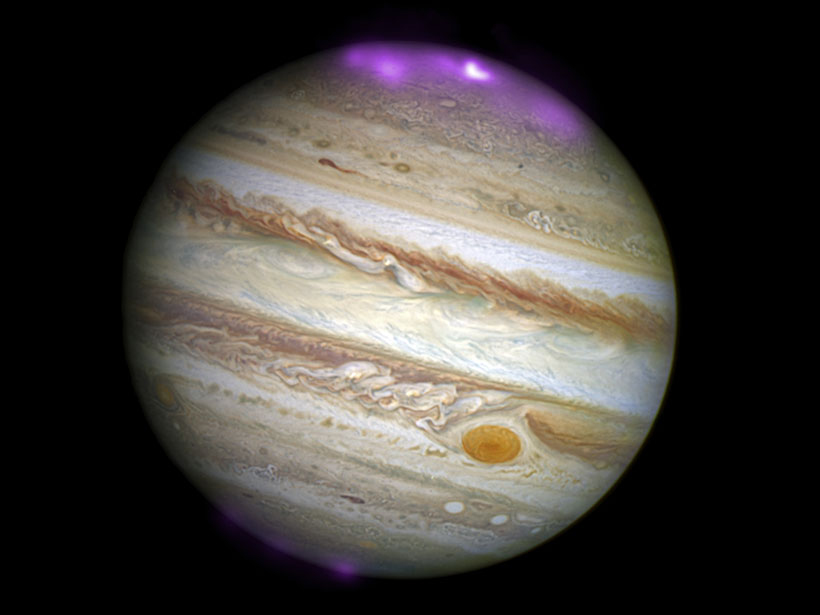Source: Geophysical Research Letters
Jupiter’s magnetic field is some 20,000 times stronger than Earth’s, thanks to its spinning, metallic hydrogen interior. As charged particles spiral along this field and collide with atoms and molecules in the atmosphere, they release energy in the form of light. This produces the most brilliant auroras in our solar system: celestial light shows similar to Earth’s aurora borealis but hundreds of times more powerful.
On Earth, auroral activity is driven by the solar wind, which bombards the magnetic field with fast-moving particles and causes geomagnetic storms. In contrast, Jupiter’s auroral activity is thought to be mainly controlled by internal drivers, thanks to its fast rotation, its strong magnetic field, and the geologically active moon Io spewing material at a rate of about 1 ton per second into Jupiter’s space environment. Observations from NASA’s Chandra X-ray Observatory show that Jupiter emits very energetic photons from its polar region—poleward of the main auroral oval of Jupiter—suggesting the presence of very energetic charged particles being accelerated downward with up to a hundred times more energy than the typical auroral particles observed at Earth.
How does Jupiter accelerate these particles to such large energies? In a new study, Clark et al. demonstrate, for the first time, how this may occur: Parallel electric fields formed within the magnetosphere accelerate electrons upward and ions downward, which may form X-ray auroras over Jupiter’s poles.
To explore this phenomenon, the researchers crunched data from Juno, a spacecraft launched in 2011 to study the planet’s magnetic fields, gravity, and atmosphere. Particle sensors mounted aboard Juno collect the energy, angle, and composition of the electrons and ions the spacecraft passes through. The team looked at a series of measurements taken toward the end of 2016, when Juno traversed Jupiter’s southern auroral region.
The data revealed particle signatures of parallel electrical fields over the poles of Jupiter that forced electrons near the poles upward, away from the planet, while protons and other ions moved downward into the atmosphere. This massive electric potential—upward of a million electron volts—provides a possible explanation of where the X-ray auroras get their energy, according to the authors.
The authors await confirmation of this hypothesis by data from from future Juno orbits, where it is hoped that Juno will cross one of the relatively confined X-ray emission regions. How exactly these electric potentials form is still a mystery, but it is an important measurement as Juno studies a long-sought link between the charged, uppermost part of Jupiter’s atmosphere, called the ionosphere, and the bubble of magnetism surrounding it, the magnetosphere. (Geophysical Research Letters, https://doi.org/10.1002/2017GL074366, 2017)
—Emily Underwood, Freelance Writer
Citation:
Underwood, E. (2017), Can large electric fields power Jupiter’s X-ray auroras?, Eos, 98, https://doi.org/10.1029/2017EO084241. Published on 19 October 2017.
Text © 2017. The authors. CC BY-NC-ND 3.0
Except where otherwise noted, images are subject to copyright. Any reuse without express permission from the copyright owner is prohibited.

